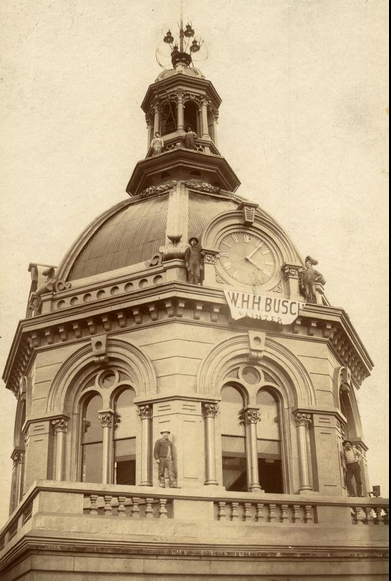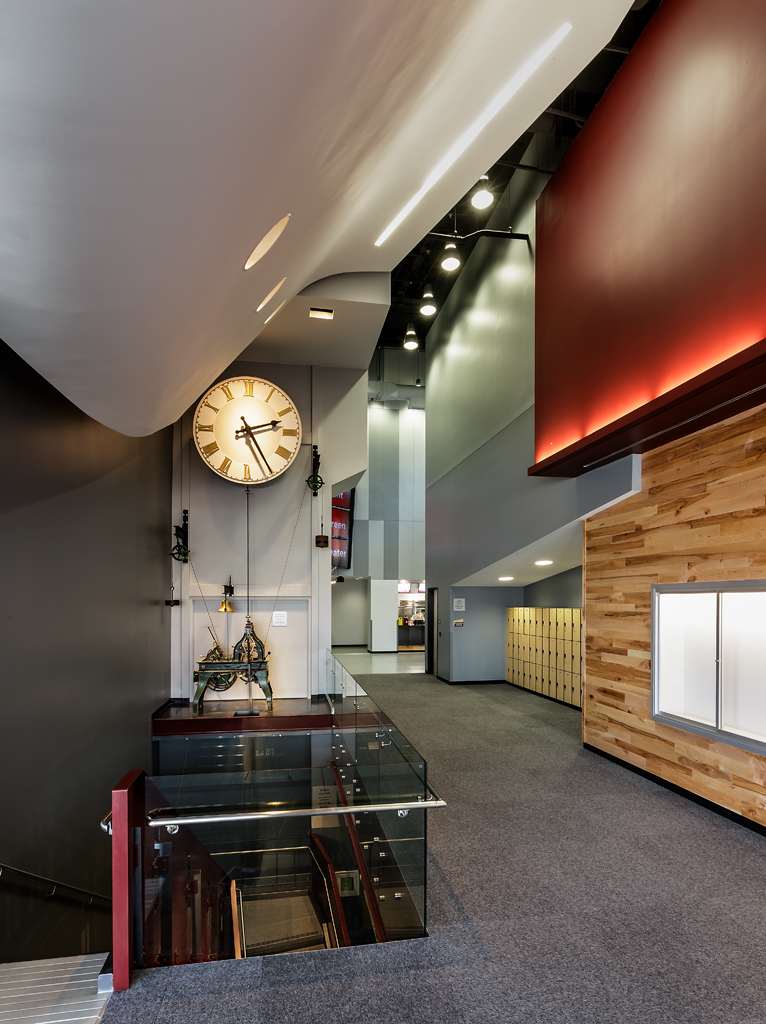
PEORIA, Ill. (AP) – Cellphones didn’t exist in 1878, the year the giant Seth Thomas clock was installed in the Peoria County Courthouse. Long before the invention of the ubiquitous modern timepiece, the courthouse clock served a very important role in most towns – it kept time for the community.
The Peoria County Courthouse clock was equipped with a 6,000 pound bell that could be heard for miles when it chimed the hour. It’s likely that mantel clocks, kitchen clocks, grandfather clocks, and all types of pocket watches in households and businesses all over Peoria were set according to that chime, even though it was frequently off by a minute or two.
By 1964, when the old Peoria County Courthouse building was slated for demolition, the clock was obsolete. In a world with electricity, batteries, radios, television and wristwatches, time-telling was much easier, not to mention more accurate. The decision was made to scrap the old clock.
Saving the clock with its four faces, 14-foot-long, 500-pound pendulum, and weights that dropped several stories before being manually wound was not an easy proposition. It would require someone with not only great mechanical skills, but also a lot of imagination – after all, where would you put it?
Fortunately for the clock – and future generations – three men over the last 52 years have had the skills, the display space and, most importantly, the interest. Because of them the 138-year-old clock still exists today, ticking and chiming every hour at the Peoria Riverfront Museum.
Endangered twice
The story of the clock’s salvation begins with Foster Vachon, a Peoria businessman who had been listening to it chime since moving to Peoria in 1926. When Peoria County decided to tear down the circa 1873 courthouse building, Vachon stepped in to save the clock at his own expense. In 1964 he removed the clock, and with the help of his brothers, restored and installed it on top of Vachon Brake Service where it ran for almost 25 years. One clock face was damaged during removal, so only three faces were displayed at the business, but the 14-foot, 500-pound pendulum was still being used, as were the weights. Vachon and his crew dug a trench beneath the building to accommodate the pendulum, and a motor was installed to wind the clock daily, reducing the length the weights had to drop.
After Vachon died, his widow donated the clock to the Peoria Airport in 1992. When plans to display it fell through, the clock was again endangered. Fortunately John Harrison Parks, co-founder of the Wheels O’ Time Museum in Dunlap, had both a place to display it and the skills to get it running again.
To the Wheels O’ Time
“I’m a clock guy from way back,” said Parks, 101, while sitting in his Dunlap clock shop Nov. 11. “From probably about 4 years old.”
Until falling and fracturing a hip later in November, Parks had been working in his shop five days a week. A retired Caterpillar engineer, Parks has restored all kinds of mechanical things over the course of his long life. As he’s grown older, he’s gravitated back to windup antique clocks, the first thing he ever took apart and reassembled.
Born in 1915, Parks grew up on a farm near Minonk, but didn’t care for farm work. In 1938 he applied for a job at Caterpillar.
“I started out stacking castings,” he said. “It was the worst job you can think of, at the foundry, working outdoors.” It didn’t take long for Parks to move into a better job. He applied for a drafting job after seeing a notice on the bulletin board.
“I took some drafting in college,” said Parks, who had attended the University of Illinois for a year prior to working at Caterpillar. Over the course of his career Parks continued to climb the ladder. Through his natural abilities and what he learned on the job, Parks retired in 1980 as a senior staff engineer, heading a department of 19.
“I had about 13 patents,” said Parks, who specialized in fuel systems. “After I retired fuel systems became electronic. At my time they were all mechanical.”
In retirement Parks focused his mechanical interests on a variety of antique machines. To contain them and preserve them for future generations, Parks and his friend Gary Bragg started the Wheels O’ Time Museum.
At the time Parks acquired the old courthouse clock he was searching the countryside for items to fill the museum. Parks and Bragg found an old TP&W caboose and displayed it on railroad track installed outside the museum. They also acquired the Rock Island Railroad “Old 886,” one of last passenger steam locomotives on the Peoria-Chicago Rocket run. Given to the City of Peoria in the mid-1950s, the locomotive was deteriorating at its spot in Detweiller Park. The Peoria Park District was more than happy to pass it on to Wheels O’ Time, said Parks.
After taking on such large projects, buying and repairing a giant old clock wasn’t that big of a deal. The airport donated the clock to the Peoria Historical Society, which officially loaned it to Wheels O’ Time. After recovering all the clock’s parts from various storage areas at the airport, Parks took it to the museum where he restored and modified it to fit the space. He replaced the 14-foot 500-pound pendulum with a different system and came up with a new way to shorten the cables holding the weights.
Alive and well
The clock had been at Wheels O’ Time Museum for nearly 15 years when Parks’ son began his campaign to get it into the Peoria Riverfront Museum.
“There were two things I thought were iconic and should go in the museum – the Duryea automobile and the courthouse clock,” said John Morey Parks, 70, while sitting in the Peoria Riverfront Museum lobby recently. The clock had just finished chiming 11 and its 14-foot pendulum swayed gracefully on the staircase below.
Placed in the walkway between the museum lobby and the parking garage, the clock is a few feet from the 1898 Duryea Motor Trap. The car was built in Peoria by Charles Duryea, who, along with this brother Frank, are considered the fathers of the American automobile industry.
It’s no surprise that Parks went to bat for the Duryea – gifted with the same mechanical abilities as his father, the younger Parks is a serious car guy. After finishing a degree in industrial design, he went to work for General Motors designing cars. In 1973 he went to Caterpillar, but he quit after 14 years with the plan of designing and marketing his own car.
With the elegant lines of a 1930s English roadster and the efficient mechanics of a modern car, the automobile turned out great, but the marketing proved to be much more difficult. Liability issues made it virtually impossible, said Parks, who continues to create original cars from scratch and from modified vintage cars as part of a very serious hobby.
When the younger Parks is not building cars, he’s working to preserve area history. In 2010 he was on the board of the soon-to-be-built Peoria Riverfront Museum when he proposed the old Peoria County Courthouse clock go into the museum permanently.
“I thought the clock would have more exposure at PRM than at Wheels O’ Time,” Parks said. At first doubtful, museum president Jim Richerson became more enthusiastic when Parks explained how the antique clock could be modified so its care and maintenance wouldn’t burden the museum staff.
“I told him I would take on the project,” Parks said.

For two years Parks worked on the clock at his Dunlap garage. Assisted by Rod Gillette, a clock repairman who works with Parks’ father, the younger Parks restored the antique works and designed a new weight system and pendulum.
“The length of the pendulum is critical in keeping accurate time,” Parks said. It had to be 14 feet long, but the pendulum bob no longer needed to weigh 500 pounds.
“The 500 pounds helped the clock withstand changes in atmospheric conditions,” Parks explained. Being essentially outdoors at the old Peoria County Courthouse, the clock needed the 500-pound pendulum bob to keep running in all kinds of weather. Since it would be indoors at the Peoria Riverfront Museum, that much weight was unnecessary. Parks instead created a 75-pound pendulum bob.
“It’s an air tank I bought at Harbor Freight Tools,” said Parks, pointing to the little tank that he painted green to match the clock mechanism. “I filled it with steel shot.”
Though the clock mechanism still worked, the escapement had been damaged at some point and Parks decided to make a new one. The escapement is what produces the tick-tock sound in a clock. It controls the energy created by the weights, doling out little doses to turn the gears, which slowly move the clock’s hands. Parks decided to create a new one with modern technology.
“I took it to Performance Pattern where they did a digital scan, then we cast a new escapement in aluminum bronze,” he said.
With the new escapement the clock now keeps excellent time, requiring only a minute or two of adjustment each month.
Because there wouldn’t be room for the weights to drop a long distance, Parks incorporated two electric motors to wind the clock three times a day. The weights, which provide the clock’s power, fall only a few feet before being hoisted up again. The motors were an important modification also because they eliminated the need for someone to manually wind the clock.
As repairs progressed, Parks was also working with the architect designing the Peoria Riverfront Museum building to determine where the clock would be placed so it would function properly and be highly visible to visitors.
The final consideration was the clock’s bell. Parks didn’t have the original bell, but at 6,000 pounds, he wouldn’t have used it anyway. Instead he installed a much smaller bell rung with a nylon hammer. The result is loud enough to get attention but not loud enough to be obnoxious.
“The original bell was huge – you could hear if for miles,” Parks said. “That wouldn’t have been very practical here.”
In the end the effort was a success. People like seeing the clock’s spinning gears, which weren’t visible when it was in the courthouse, and museum staff appreciate the fact that the clock doesn’t require their efforts. What little maintenance it needs is provided during monthly visits by Gillette.
Though Parks is no longer a board member at the PRM, he has frequent opportunities to see the old clock. During his recent visit to the museum he paused to listen when the clock started clicking and whirring.
“It’s winding,” he said, clearly delighted.
Though Parks spent a lot of time working out the plan before installing the clock at the museum, he didn’t know how well it would work until the clock was in place. The fact that, four years later, the clock is alive and well pleases him.
“I’ve built enough stuff in my life that I’m always amazed when it actually works.”
___
By LESLIE RENKEN, (Peoria) Journal Star
Source: (Peoria) Journal Star, http://bit.ly/2iEKJqc
___
Information from: Journal Star, http://pjstar.com
Copyright 2017 Associated Press. All rights reserved. This material may not be published, broadcast, rewritten, or redistributed.
AP-WF-01-09-17 1050GMT


